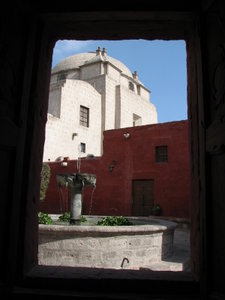Advertisement
Published: March 27th 2009

 Dome and fountain
Dome and fountain
Monasterio de Santa CatalinaWe bused straight from La Paz to Arequipa, in Peru. Since we had already made the same journey the other way, this time we felt like experts. When the bus driver told all the confused tourists - in Spanish - to get off the bus and catch the water taxi across the lake, we knew just what to do! Getting entrance and exit stamps in our passports... no problem! We led the pack of gringos like shepherds.
The remainder of the bus ride, however, was long, hot, and terrible. The later portion was even accompanied by a second bout of food poisoning. So the first few days in Arequipa were spent in recovery.
Once all better, we went to visit the Monestario de Santa Catalina. In its prime, this convent housed approximately 400 nuns, servants and slaves in the area of about one city block And apparently, it was the place to be! In the early days, the rich widow who ran the convent would only accept rich young women who could provide large dowries. And when accepted, all the novices and nuns did was party. This went for over a century until the Pope demanded charge of the

 Blue area in Monasterio
Blue area in Monasterio
Blue walls denotes a private area in these types of old buildings. Note the stairs to nowhere.convent, and began overseeing who was accepted as well as what happened within.
The monestario is huge, containing many many rooms and several streets and alleyways within its exterior stone wall. Throught its history, the convent took in children of the community for schooling, and was a safe-haven during earthquakes for the community. In fact, the convent has withstood multiple earthquakes and other natural disasters, requiring multiple restructurings. As consequence, the convent has been the subject of many architects. The result is a building riddled with miniature doors and stairways to nowhere. Very interesting, and slightly eerie.
Arequipa also has many old colonial mansions open to the public, although many of them are now used as banks or for government institutions. We visited one of these, which was beautiful inside. We had a free tour from the cutest girl, who gave us the entire history of the families that lived there, along with interesting facts. Many of the paintings in the house were done by Quechua artists, who were forced into this work and weren't allowed to sign their pieces. As a signature, they secretly included mistakes in the paintings, such as a subject having two left hands,
or a face in a dark corner.
Advertisement
Tot: 0.096s; Tpl: 0.011s; cc: 13; qc: 70; dbt: 0.0561s; 1; m:domysql w:travelblog (10.17.0.13); sld: 1;
; mem: 1.1mb

 Dome and fountain
Dome and fountain
 Blue area in Monasterio
Blue area in Monasterio






